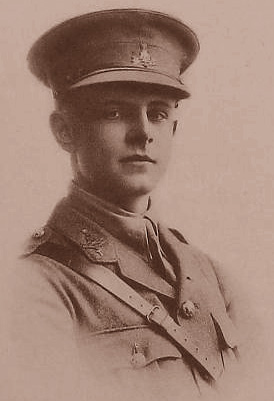
2nd Lt A J B Richardson.
|
2Lt Richardson Arthur John Buchanan died, aged 19, on the 4th January 1915. Born at Guisborough.
He was the eldest son of Colonel William Richardson, V.D. solicitor, of Guisborough and of Averil Mary his wife, daughter of Arthur Buchannan, solicitor of Guisborough, N Yorks of Daneholm, Sandsend, Whitby, N Yorks.
He entered Rugby Public School, Warwickshire in 1909 and left in 1913.
He entered in August 1913 as an Articled Clerk the firm of Solicitors founded by his great grandfather and carried on by his grandfather.
He received his Commission in the 4th Battalion, The Yorkshire Regiment in June, 1913, and went to camp with them in
August, 1913.
He was again in camp in August 1914, at Colwyn Bay, when War broke out. The Regiment was recalled
into training at Darlington, when he was given the command and a new Company of Signallers.
He next went with the Battalion to Newcastle on Tyne, on coast defence.
He died in his billet at Newcastle after twelve hours' illness of cerebro-spinal meningitis, contracted on service, on January 4th, 1915,
three months before his Battalion went out to France.
A local newspaper report, headed "Cleveland Mourns the Death of a Gallant Officer",
provides details of a military funeral at Guisborough Church attended by local dignitaries.
|
The coffin was borne by men of the 4th Battalion, with fellow Officers Colonel Bell, Captain Charlton and Lts Williams
and Jervelund present. Men of the 7th Devon Territorials, who were stationed in Guisborough at the time, also paraded.
The Union Jack draped coffin was interred in Guisborough Cemetery with the customary firing of three volleys and buglers
sounding the Last Post.
His Colonel said:-
"Remember that he died for his Country every bit as much as though he had been killed at the Front."
His Adjutant wrote :-
We all simply loved the boy. From my professional point of view he was a thundering good soldier, most capable and keen, and a boy whom
any regular Regiment would have scrambled to get. His cheeriness would have been a godsend to us in France."
Other tributes to his memory were as follows:-
"When he died, the sunshine went out of our lives."; "He was beloved by all."; "Wherever Jock is now, he is making someone happy. I have
known many men in my time, but never one with quite his fascination, and we all felt it."
Not on the battle field, yet none the less
He died for England in her hour of stress
And peril, his young life he freely gave,
And rests with honour in his quiet grave.
|

|
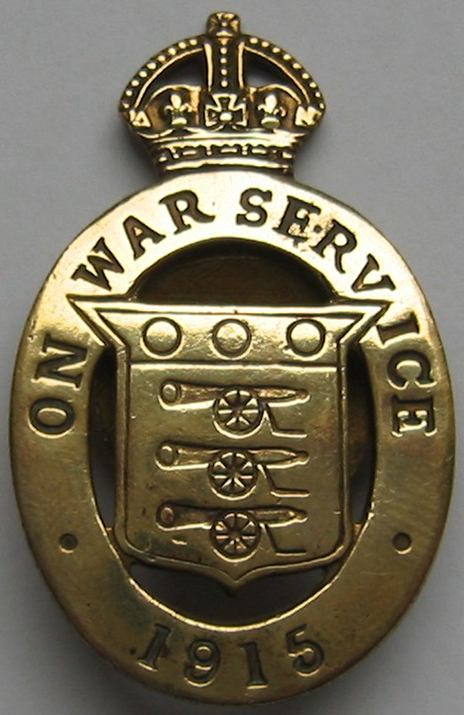
|
Men in vital occupations were intially exempt. This photograph is of Bert Bell of Yarm, N Yorks. He enlisted for war service in 1914.
However he was a furnace man at Urlay Nook, which was classed as a reserved occupation.
The lady is his wife, Margaret Suggett. Her brother, Anthony Suggitt, died with the 1st Yorkshire Regiment in India
The little boy is Jimmy Bell, who served in the 4th Yorkshire Regiment (Green Howards) in WW2. He was in the Yarm Territorials.
The badge that Bert is wearing is the 1915 Exemption Badge. Men who were old enough to fight were often accused of cowardice, especially by women who had husbands and sons serving.
The Exemption Badges were issued along with a certificate to prove identity, so that they could not be easily used by others trying to avoid service.
Secondly, each year, the badge was different and was re issued.
So if a man had a 1914 exemption badge, but that exemption had expired, then he wouldn't be able to wear the same badge for the duration of the War.
Similarly lads who had been wounded and no longer fit for service were awarded a Silver Badge.
Conscription was eventually introduced in 1916, as the need for reinforcements grew.
Bert was eventually called up and was killed on the 8th January 1918, while serving with the East Yorks Regiment.
[Both photographs have been kindly contributed by Bert's Great Grandson, Martin Jones, of Ferrensby, near Boroughbridge, N Yorks.]
|
|
20 to 29 JANUARY Drafts totalling 166 other ranks were received from 2/4th Btn at Cramlington, Northumberland.
5 FEBRUARY. The North Eastern Gazette for this day carried this photograph of Pte Thomas Sayers
and the caption - "Drummer Thos Sayers [age 15 and a half] 38 Albert St, Middlesbrough, who is with the 4th Batt. Yorks
Regt, stationed at Newcastle. He volunteered to go to the front several times, has been accepted, and expects to go
shortly." Kevin Galloway of Thornaby has kindly contributed this photograph and Thomas Sayers' fascinating story -
Click here.
|

Thomas Sayers.
|
5 APRIL. 2789 L/Cpl John Ronald Watson Williams was commissioned and later transferred to the Royal Engineers. He was to be killed in action on the 12 April 1918 at the Battle of the Lys and is commemorated on the Ploegsteert Memorial.
15 APRIL. The difficulty in obtaining more recruits at home was already apparent. The Lord Lieutenant of the North Riding had been asked to raise a battalion for Kitchener's New Army:-
The War Emergency Committee advised the Association to draw the attention of the Army Council to the fact that the Territorial Force Units in the North Riding now require 1,200 men to complete the quotas so far called for and that there appears to be no possibility of obtaining such a number or of replacing future wastage, by any recruiting methods at present permissible by law and War Office Regulations.
16 APRIL. The first part of the year was spent in training in the Newcastle area and on this day the order was
received for the whole of the Northumbrian Division to proceed to the Continent.
17 APRIL. The Battalion left Newcastle at 9 am bound for Folkestone.
"Saturday.
Dear Mother & Father,
Just a line to let you know we are all well. We left Newcastle at 9 this morning, for Folkestone.
We had a good send
|

|
off. I threw this out at Northallerton.
From your loving son,
Joe."
[Joseph Burn, of Brompton, nr Northallerton, was to be killed 15 days later at Ypres.]
Around midnight they were taken across the Channel to Boulogne.
18 APRIL. After arriving at Boulogne about 2 am, they spent a very cold night camped on nearby hills.
Leaving Boulogne at 10 pm, they marched to Desveen, from where the French Railways took them to Cassel, the Officers
riding in first class carriages, NCOs and men in cattle wagons behind.
19 APRIL. After arriving at Cassel at 5 in the morning, they marched to
Godwaersvelde, where they were billeted
in surrounding farm buildings.
Here over 4 days the 4 Battalions of the 150th Brigade of the 50th Division gathered.:-
The 1/4th Yorks, the 5th Yorks,
the 4th East Yorks and the 5th Durham Light Infantry.
The Brigadier was Brig-Gen J E Bush.
The Commander of the
50th Division was Major-General,Sir W Lindsay. KCB. DSO, who remained in this position until the 29th June 1915.
21 APRIL. An order came at night to detail 400 men to proceed by bus to an unknown destination, but this was
later cancelled.
|
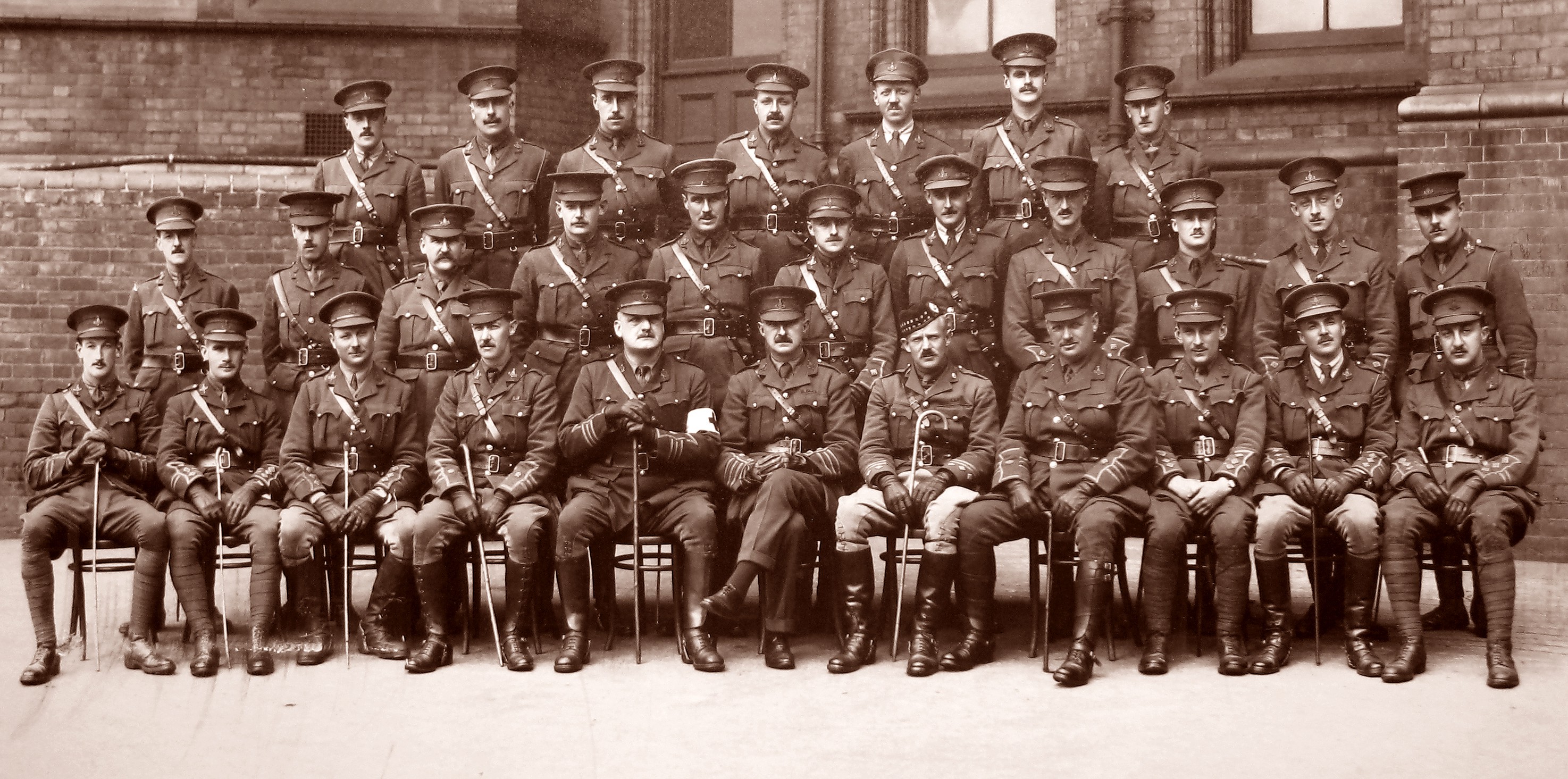
Officers of the 4th Yorks Battalion, 14th April 1915 at Newcastle.
Top Row - 2nd Lt H B Blackett, Lt T Rowlandson, 2nd Lts H Hewitt, E Darwin, J K Stead, A Welsh, G A Tugwell.
Second Row - Lts H W Cummins, T H Hutchinson, Lt & Quartermaster W H Colton, E Williams, Capt N W Stead, 2nd Lt H Fawcett, Lts
C C Jervelund, L I I'Anson, 2nd Lt P Orde-Powlett, Lt A Beresford-Peirse, 2nd Lt C Sproxton.
Sitting - Capts J Maughan, W W Constantine, A Graham, Majors H C Mathews, H de Legh [RAMC], Lt Col M L Bell, Capt & Adjt G Eykyn
[The Royal Scots], Major H Scott, Capts R A Constantine, G Bowes-Wilson, J Nancarrow.
[Photograph kindly contributed by David Blanchard of Skipton, N Yorks and Simon Barnard of York.]
|
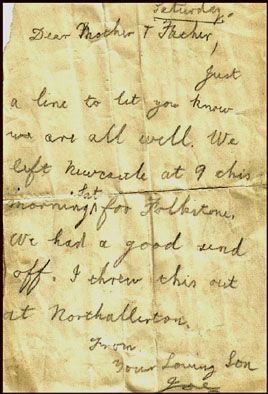
Joe Burns' letter.
[Photocopy kindly donated by his Great Nephew, John Burn.]
|
An as yet incomplete list of all the other ranks who went to France at this time can be seen -
here.
22 APRIL. The Northumbrian Division had been expecting a period of further training and familiarisation with
the situation, which was the usual procedure for new arrivals.
At 5 pm on this day, the Germans threw any such plans into disarray by starting an offensive which was to become
known as the Second Battle of Ypres.
The Infantry Battalions of the Northumbrian Division had to be thrown straight into battle, within a week of sailing
from England.
The Germans began their onslaught with a new sinister weapon.
They released 6,000 canisters of chlorine gas along the North East edge of the Ypres Salient
This section was being defended by French Colonial troops.
The Ypres Salient was a bulge into the German line that had been made by the British regular Army in its defence of Ypres in
1914. It extended some five miles to the East of the town, low-lying agricultural land, dotted with Belgian villages and
criss-crossed by the dykes that drained it.
"Utterly unprepared for what was to come, the French Divisions gazed for a short while spellbound at the strange
phenomenon they saw coming slowly toward them.
Like some liquid the heavy-coloured vapour poured relentlessly into the trenches, filled them, and passed on.
For a few seconds nothing happened; the sweet-smelling stuff merely tickled their nostrils; they failed to realize the
danger. Then, with inconceivable rapidity, the gas worked, and blind panic spread.
Hundreds, after a dreadful fight for air, became unconscious and died where they lay - a death of hideous torture,
with the frothing bubbles gurgling in their throats and the foul liquid welling up in their lungs.
With blackened faces and twisted limbs one by one they drowned - only that which drowned them came from inside and
not from out.
|
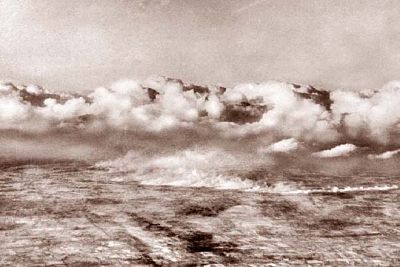
Clouds of Poison Gas at Ypres.
|
Others, staggering, falling, lurching on, and of their ignorance keeping pace with the gas, went back.
A hail of rifle fire and shrapnel mowed them down, and the line was broken.
There was nothing on the British left - their flank was up in the air.
The northeast corner of the salient around Ypres had been pierced. From in front of St. Julien away up north toward
Boesinghe there was no one in front of the Germans."
The Germans attacked, but had only primitive protection and were fearful of the gas themselves.
They had captured the bridge at Steenstraate and some works south of Lizerne, but they failed to take full advantage
of the situation.
They were not fast enough to prevent the Canadian troops on the right of the French heroically closing in to prevent
a complete breakthrough. They held the German advance which had progressed a mile or more and by midnight the 10th
Bn of the Alberta Regiment and the 16th Bn of the Canadian Scottish had bravely regained
possession of the wooded area immediately in front of the village of St Julien - Kitchener's Wood.
It was vital now for all British troops in the sector to be pushed forward to fill dangerous gaps.
|
Private W. Hay of the Royal Scots arrived in Ypres just after the chlorine gas attack on 22 April 1915:-
We knew there was something was wrong.
We started to march towards Ypres but we couldnít get past on the road with refugees coming down the road.
We went along the railway line to Ypres and there were people, civilians and soldiers, lying along the roadside in a terrible state.
We heard them say it was gas.
We didnít know what the Hell gas was.
When we got to Ypres we found a lot of Canadians lying there dead from gas the day before, poor devils, and it was quite a horrible sight for us young men.
I was only twenty so it was quite traumatic and Iíve never forgotten nor ever will forget it.
The French soldiers were naturally taken by surprise.
Some got away in time, but many, alas! not understanding the new danger, were not so fortunate, and were overcome by the fumes and died poisoned.
Among those who escaped nearly all cough and spit blood, the chlorine-attacking the mucous membrane.
The dead were turned black at once.
About 15 minutes after letting the gas escape the Germans got out of their trenches.
Some of them were sent on in advance, with masks over their heads, to ascertain if the air had become breathable.
Having discovered that they could advance, they arrived in large numbers in the area on which the gas had spread itself some minutes before, and took possession of the arms of the dead men.
They made no prisoners.
Whenever they saw a soldier whom the fumes had not quite killed they snatched away his rifle and advised him to lie down ďto die better.Ē
23 APRIL. About 1 pm the whole 4th Yorks Battalion was embussed to Poperinghe, from where they marched to huts at Camp "A",
between Vlamertinghe and Ypres.
They arrived about 5 pm and stayed the night there.
24 APRIL. At 1 a.m the 150th Brigade set to march to the Yser Canal.
|
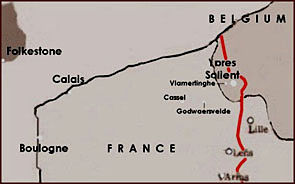
The 4th Btn arrived in France on the 18th April 1915 and expected the usual period
of training and familiarisation with Trench warfare.
Instead they found themselves in the path of a German offensive.
|
The night was black with steady rain.
It was their first taste of battle.
Marching towards the unknown, past "gaping shell holes, broken-down wagons, limbers
and ambulances" must have been an awesome experience for lads who had never been away from home before.
The 5th Yorks Bn crossed the Canal, but the 4th remained on the Western side. All they knew was that the Germans had
pressed their attack on Ypres, the Canadians had suffered many casualties from the poison gas and there was a wide gap in
the line to the North East of Ypres.
As soon as it was light the German Artillery opened up.
All the morning the Battalion were being shelled at intervals and had 5 slight casualties, among whom was 2nd Lt Geoffrey
Arnold Tugwell. [He was wounded again in 1916 on the Somme and finally killed at Arras, as a Captain, on the 23rd April 1917.]
At 4 in the morning the Germans had released more gas and the Canadians in the front line with only wet handkerchiefs
and the like for protection held on.
At 6.30 a.m there had been a break in their line and they requested support.
The Ypres Salient was of a saucer shape with the Germans, who had a superiority in Artillery commanding the rim.
|
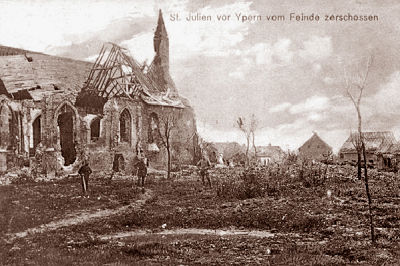 Germans at St Julien.
Germans at St Julien.
|
At mid-day the Btn was ordered to cross the Canal by a pontoon bridge and advance to the village of St Jean in support
of the 3rd Canadian Brigade and to concentrate at Wieltje.
They crossed the Yser Canal under fire. Lt E W Faber was severely wounded. All four Companies managed to cross before
a shell wrecked the bridge, leaving the machine gun, limbers and Medical Officer's cart on the other side.
They were told that they were being attached to one of the Canadian Brigades.
A Canadian Brigadier ordered them into a section of G H Q Trenches outside the Potijze Chateau and sent a guide with
them.
On arrival they found the trenches full of troops who were being heavily shelled. They lay down behind the trenches
while the CO endeavoured to get orders.
The Brigadier of another Canadian Brigade ordered them and the 4th East Yorks to attack through the village of Fortuin
and on to the village of St Julien.
The lads of the 150th Brigade, who knew little of this War until then, took him at his word
and began to advance as if it was their offensive.
Unknown to them the Germans had already captured St Julien about 3 pm and were moving South.
|
|
They had already advanced some two miles and were anticipating a complete breakthrough to the Channel ports. They must have been amazed
to see troops attacking them when up till then they had been retreating and it was acknowledged afterwards that this bravery prevented
the Bosche from gaining their objective.
|
 German 10.5 Howitzer Team at St Julien.
German 10.5 Howitzer Team at St Julien.
|
The two battalions had very little Artillery support.
At that time the British guns were not supplied with a sufficient number of shells.
They proceeded, as the Diary says, with "both flanks up in the air", i.e being fired on by German Artillery from the
front and from both sides as well.
They moved forward in a diamond formation under cover of a slight rise of ground on the left. Having advanced for the
best part of a mile in a North Easterly direction parallel to the Wieltje-Fortuin road they had to close up to cross a
deep and muddy stream. They then proceeded in dead ground until coming level with the village of Fortuin, where they
encountered chiefly from the left flank shelling and a certain amount of long range machine gun fire. The line now changed
direction, the two leading Companies taking shelter in a sunken road opposite Fortuin, which so far as could be judge
was only lightly held. They could not find anyone in superior command.
The noise of fighting could be heard from the direction of St Julien, which seemed to be occupied in considerable force,
with the enemies advanced parties holding the banks of a muddy stream some 500 yards south of the village.
They saw a few men retiring.
|
 Fortuin, St Julien. 24th April 1915.
Fortuin, St Julien. 24th April 1915.
|
The ground between the sunken road at Fortuin and this stream was level grassland.
Some
200 yards south of the stream, however, there was a slight fold in the ground which seemed to give promise of affording
a suitable position from which to attack and drive in the advanced German posts.
Two Companies now advance by rushes and
the Germans were forced into falling back on St Julien.
The other two Companies were held back in reserve on the Left
as this seemed to be the more exposed and dangerous flank.
At this point the Adjutant of the 4th East Yorks appeared and
reported to the OC of the 4th Yorks that his Battalion had been sent up in support, that his CO and Second in Command
had both been killed and asked for orders.
The two reserve Companies and the East Yorks were directed to prolong the
line to the Left
Both Battalions lost heavily while crossing the open ground, but the Germans were driven back into
St Julien. A platoon of Royal Irish Fusiliers came up on the right and later some of the Yorks and Lancs Regt to
prolong the line in this direction.
It was here they got the name of the "Yorkshire Gurkhas" from the R.I.F. Any attempt
to cross the stream between the British line and St Julien would have resulted in heavy losses owing to the volume of
machine gun and rifle fire that the Germans in the village could bring to bear.
There seemed to be a fair chance of the Battalion along with the 4th East Yorks being cut off and unable to extricate
themselves.
They passed down the order to hold on to the ground that they had gained till dark.
This they did and then received orders to fall back on Potijze Chateau and this was carried out without hindrance.
|
|



